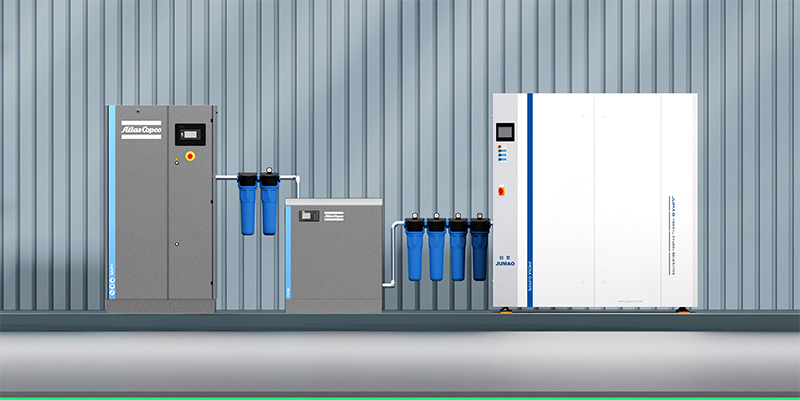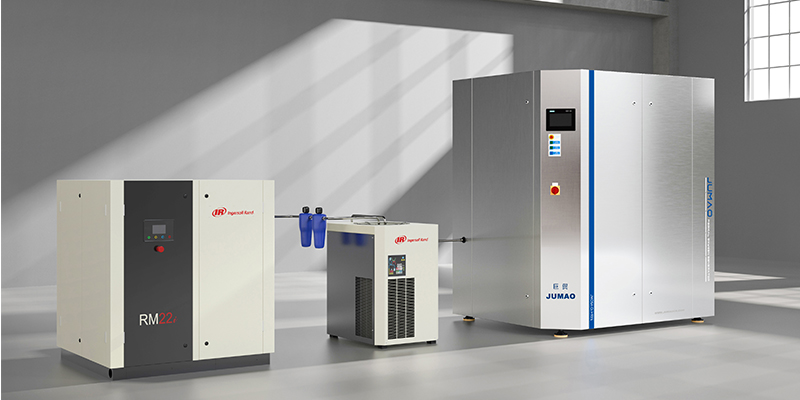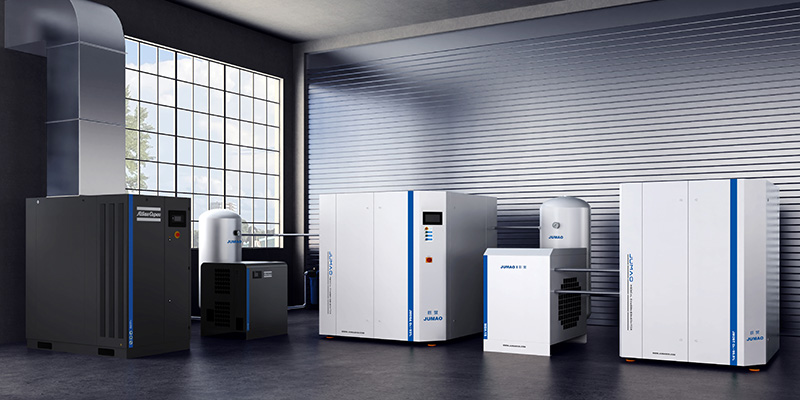With the continuous development of oxygen production technology, medical oxygen has evolved from the initial industrial oxygen to liquid oxygen and then to the current pressure swing adsorption(PSA) oxygen production. The oxygen supply method has also developed from direct oxygen supply from a single bottle to a centralized oxygen supply system. Currently, centralized oxygen supply systems, central suction systems, and compressed air systems have become the three essential medical gas supply systems in modern hospital clinics.
Oxygen is a key substance for human metabolic activities and the first necessity for human life movement. Oxygen supplementation can improve the physiological and biochemical internal environment of the human body and promote the benign cycle of metabolic processes, thereby achieving the pirpose of treating diseases, alleviating symptoms, promoting recovery, preventing lesions, and improving health.
Therefore, oxygen plays an important role in the medical field, especially in the first aid of critically ill patients and those with accidental injuries, and oxygen supply has become one of the necessary conditions for medical institutions.
The development histiry of hospital oxygen supply system
Single bottle direct oxygen supply
Direct oxygen supply from a single bottle is the traditional way of supplying oxygen in hospitals, and this method has always been used to supply industrial oxygen. Since industrial oxygen often contains harmful gases and the inner wall of the cylinder will rust, the oxygen will have a nauseating odor. When used clinically, it will cause patients to cough and aggravate respiratory symptoms.
Therefore, in order to ensure the health of the people, China has revised the standards for medical oxygen.
Centralized oxygen supply
Oxygen supply, also known as central oxygen supply, is a modern oxygen supply method widely used internationally. China developed the first central oxygen supply system in 1983, it has been widely promoted and applied in large and medium-sized cities. At present, all hospitals of a certain scale have adopted central oxygen supply systems. Moreover, the medical gas supply system composed of centralized oxygen supply system, central suction system and compressed air system has become a must-build project for the construction and renovation of ward buildings in hospitals and a necessary project for hospitals to upgrade.
Centralized oxygen supply technology can improve the medical level of hospitals, enable patients to receive timely rescue or treatment, and thus save many lives. At the same time, since the equipment for centralized oxygen supply technology is relatively concentrated, it is conducive to the modern management of hospitals.
Specifically, the following aspects are reflected:
- The centralized oxygen supply pipeline has a lower pressure and is equipped with multiple safety devices, making it safer and more reliable
- Centralized oxygen supply does not require oxygen cylinders to be carried to the ward, making storage and transportation easier
- The centralized oxygen supply system has strong oxygen supply capacity, large capacity, stable pressure, and can provide large-flow continuous oxygen supply
- The oxygen inhalation terminal for centralized oxygen supply is directly installed in the operating room, emergency room and wards of each ward, making oxygen inhalation simple, easy, safe and reliable
- Centralized oxygen supply can significantly improve oxygen utilization, reduce the number of oxygen management personnel, and thus improve economic benefits
The central oxygen supply system of a hospital consists of oxygen source, oxygen pipeline, valve and equipment with terminal. At present, busbar, liquid oxygen and pressure swing adsorption(PSA) oxygen concentrator are commonly used as oxygen source of oxygen supply system at home and abroad.
Busbar
Busbar oxygen supply system is mainly composed of two sets of high-pressure oxygen cylinders(one for gas supply and one for backup). It consists of a busbar, a set of automatic/manual control devices, sound and light alarms, pressure reducing and stabilizing devices, pipe and accessories. When the oxygen supply is about to run out, the busbar can automatically switch to the backup oxygen supply.
The control device has a pressure gauge, a monitoring control unit, and alarm system and indicator lights to display the operating conditions and remind the user to replace the exhausted oxygen cylinder. If the automatic control device fails, the backup pressure reduction and pressure stabilization device will be put into operation to ensure the stability of the oxygen supply pressure.
Liquid oxygen
The gas source system using liquid oxygen as the oxygen source is mainly composed of a liquid oxygen tank, a vaporizer, a pressure reducing device and an alarm device. The liquid oxygen is added from the transport vehicle’s liquid oxygen tank to the liquid oxygen tank of the centralized oxygen supply system by utilizing the pressure difference between the inside and outside of the liquid oxygen tank. The liquid oxygen tank is a high-pressure insulation interlayer to ensure the required low temperature of the liquid.
The temperature of liquid oxygen rises sharply when is flows through the vaporizer, causing ir to vaporize. The high-pressure vaporized oxygen is reduced in pressure by a pressure reducing device and is then sent out after the pressure is stabilized. There are gengerally two liquid oxygen tanks in a system, one for oxygen supply and one for backup; the liquid oxygen tank and the busbar can also be used in conjunction, with the liquid oxygen tank supplying gas and the busbar being used as backup.
Medical PSA oxygen concentrator oxygen supply
The oxygen supply system of the medical PSA oxygen concentrator is mainly composed of an air compressor and dryer, a filter, an oxygen concentrator, an oxygen storage tank, pipes and accessories. If oxygen filling is required for oxygen cylinders, and oxygen compressor and an oxygen filling station can be set up. The PSA oxygen generator uses pressure swing adsorption oxygen production technology to obtain oxygen with a purity of ≥ 90% that meets medical oxygen standards.
Pressure swing adsorption oxygen production technology uses the selective adsorption of oxygen and nitrogen by zeolite molecular sieves, and the characteristics that the adsorption capacity increases with the increase of adsorption pressure and decreases with the decrease of adsorption pressure. It adsorbs nitrogen under pressurized conditions to enrich oxygen; desorbs the adsorbed nitrogen under reduced pressure conditions, and regenerates the molecular sieve at the same time. This reciprocating cycle achieves the separation of oxygen and nitrogen and the production of oxygen.
The use of medical PSA oxygen generators can be configured as a single unit or a dual unit. In a single unit configuration, one set of oxygen generator equipment is used, and the oxygen cylider busbar is used as a backup. During the peak oxygen demand, the oxygen cylider is supplemented through the busbar, which is both economical and safe and reliable. In a dual unit configuration, two sets of oxygen generator equipment are configured, which is convenient for parking and maintenance, and there is a backup oxygen busbar as a guarantee, which is safer and more practical.
Simplicity comparison
Busbar oxygen supply requires the regular purchase of medical oxygen cylinders, which are complicated to transport, handle and manage, and the cylinders need regular maintenance.
Liquid oxygen is a great improvement over busbars, with the advantages of large transport volume, high transport efficiency, less auxiliary time, and low oxygen cost. A 3.65m3 liquid oxygen storage tank, filled with liquid oxygen and fully gasified, can produce 3000m3 of oxygen, which requires 500 steel cylinders, and the weight of the steel cylinders alone is about 30t.
Liquid oxygen storage tanks only need to be filled 1-2 times a month, but the operating requirements during filling are very high, and operators must certified to work, check the output pressure every day, and regularly inspect and maintain the equipment. The oxygen use procedure is relatively cumbersome.
The medical PSA oxygen generator realizes on-site oxygen production and establishes its own independent oxygen production station. It dose not require oxygen transportation and is not restricted by the second oxygen source. The equipment can be operated automatically without frequent adjustment and calibration. It is safe, simple and convenient to operate. No other auxiliary equipment is required, and qualified medical oxygen can directly enter the pipeline system, making the hospital management more scientific and medern.
Security comparison
The oxygen pressure in the oxygen cylinder used for busbar oxygen supply is relatively high, generally 15MPa(150 atmospheres), which may cause potential explosion if encountering strong vibration and collision. The quality and purity of the oxygen in the oxygen cylinder are not under the control of the user.
Liquid oxygen is the most important safety concern. A large amount of liquid oxygen is stored in the liquid oxygen storage tank. The temperature of liquid oxygen is extremely low(-183°C), and oxygen is a strong combustion agent. Once is leaks, the consequences will be dusastrous. Therefore, the liquid oxygen system needs regular inspections. If the explosion-proof disk on the liquid oxygen tank explodes or exhaust valve jumps to exhaust, it means that vacuum of the liquid oxygen tank’s interlayer is destroyed and it should be repaired and re-vacuumed.
It is dangerous to place liquid oxygen tanks in densely populated hospitals. Liquid oxygen is prone to leakage during transportation and packaging, and even a small amount of grease may cause a fire, posing a safety hazard.
Medical PSA oxygen generators operate at normal temperature and low pressure(20°C-40°C,6-8 atmospheres). There are no unsafe factors in principle and it is the safest of the three oxygen supply methods. Oxygen concentrators are generally equipped with a backup busbar oxygen source to ensure the supply of oxygen in the event of a power outage, shutdown, or when oxygen consumption suddenly increases for a period of time and exceeds the rated oxygen production of the oxygen concentrator.
Economic comparison
The busbar system uses oxygen cylinders, which are generally available in hospitals. All that needs to be done is to process the cylinders and then assemble them, thus saving initial investment costs.
Choice of oxygen supply method
Since busbar oxygen supply requires the least initial investment, for some small and medium-sized hospitals, which have a small capacity to receive patients and a shortage of funds, using busbar oxygen supply is the most practical and economical method. From the perspective of long-term economic operation, the hospital PSA oxygen generator is the most economical way of oxygen supply. The system has a high safety factor and can be operated unmanned and managed in a modern manner. It is the best choice for modern hospitals.
Therefore, at present, large hospitals should use hospital PSA oxygen concentrators for oxygen supply. At the same time, since PSA oxygen concentrators do not require a second oxygen source and can supply oxygen normally with only electricity, they are also suitable for some remote areas and areas with inconvenient transportation.
System pipes and terminals
Oxygen is transported from the oxygen station to each floor(ward, operating room, rescue center, outpatient clinic, etc.). After secondary pressure stabilization, the oxygen output pressure is 0.1-0.4MPs(adjustable). The ambient temperature around the oxygen pipeline should not exceed 70°C.
Open flames and oil stains are strictly prohibited near pipelines or valves. Oxygen delivery pipelines can be made of copper pipes or stainless steel pipes. The former is more economical and is the preferred material specified by national standrads
After the oxygen tube enters the ward, it is connected to the terminal plate(also called a treatment belt). The terminal plate is a guide groove for various wire and an assembly of various pipeline terminal components.
Post time: Jun-09-2025



